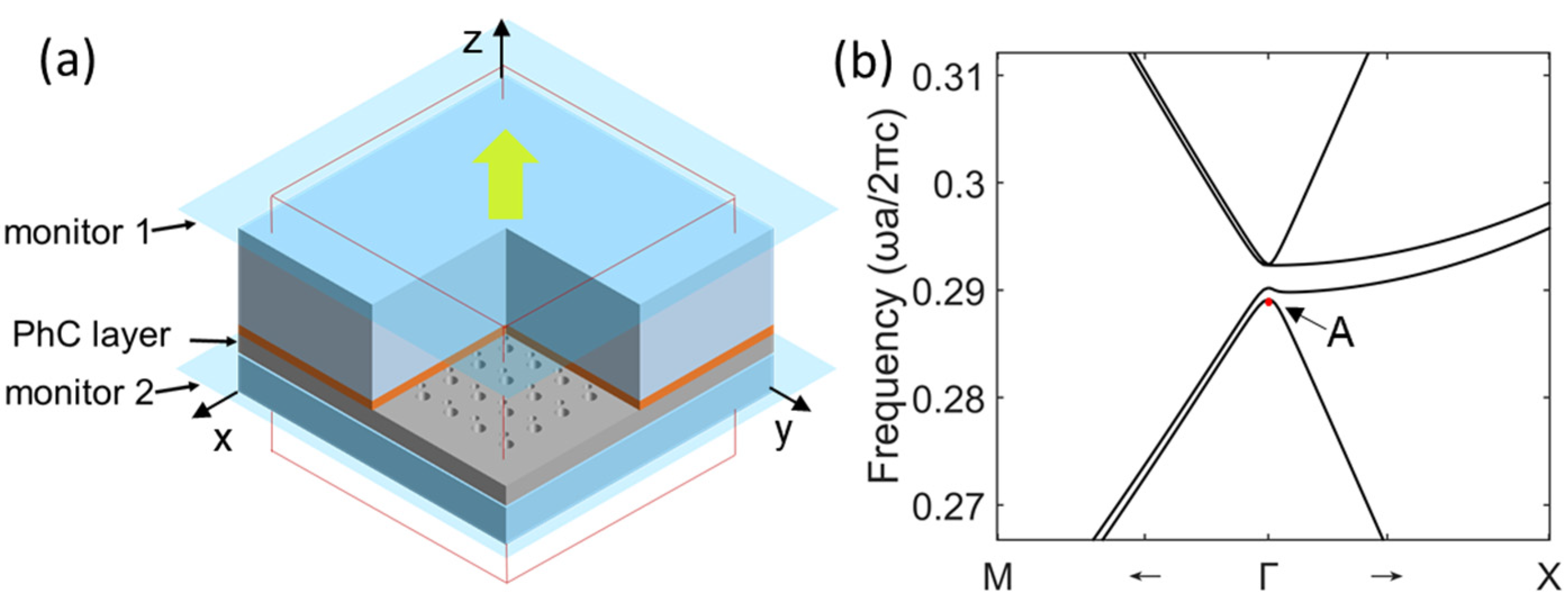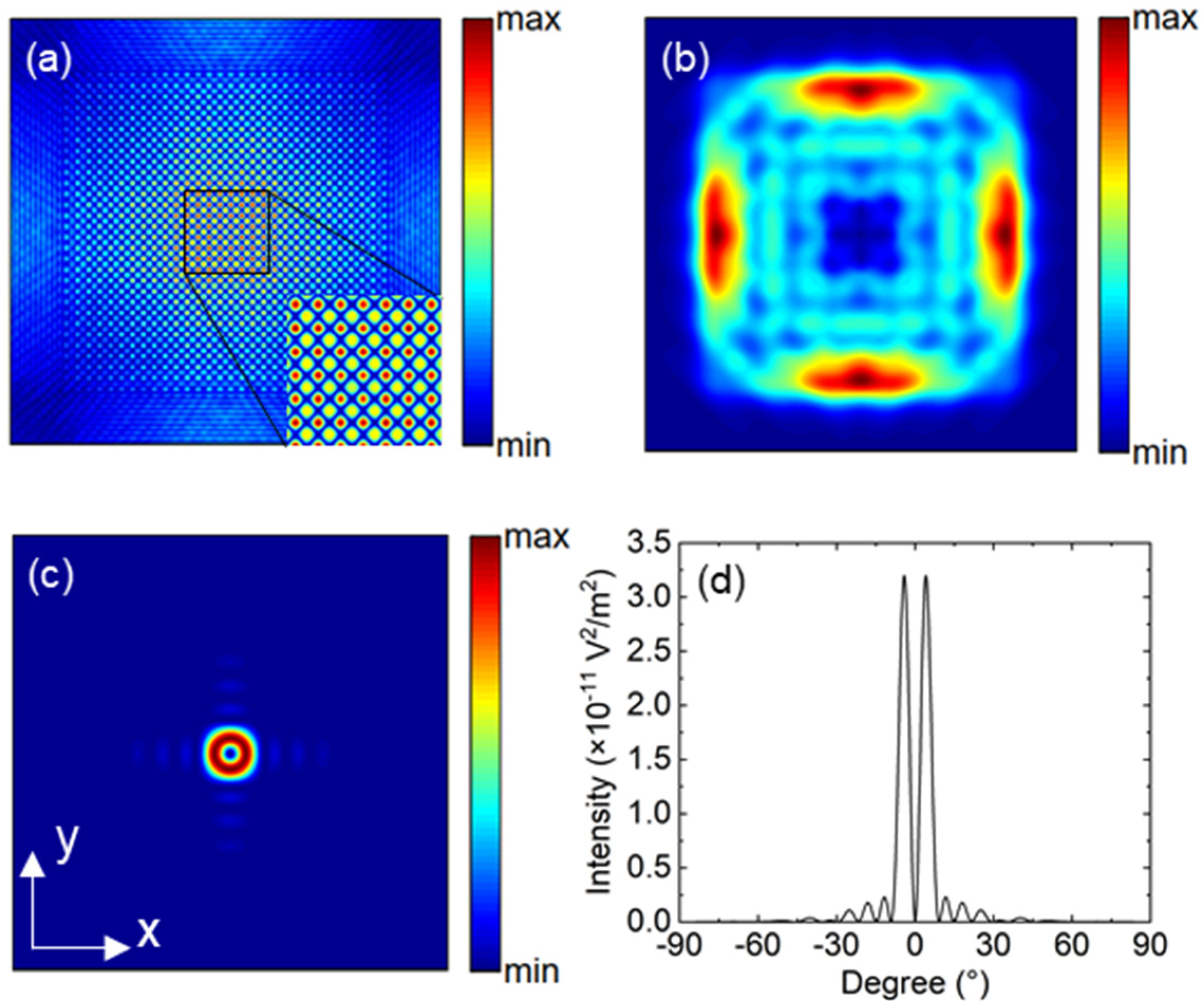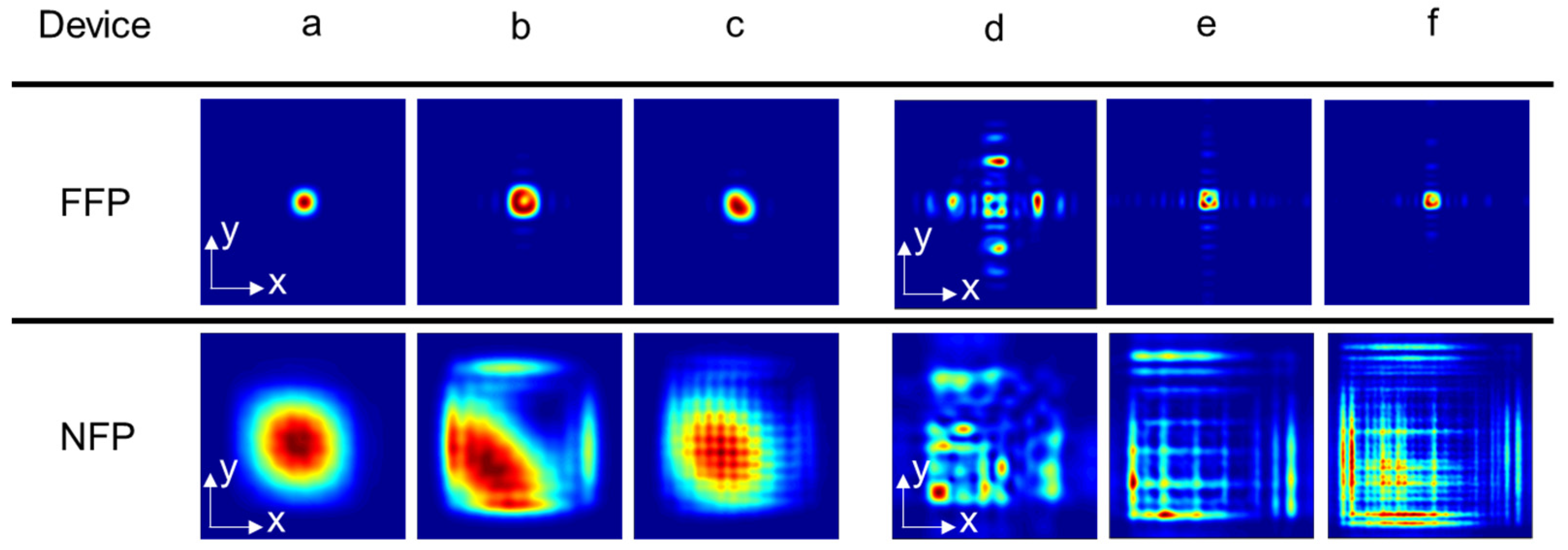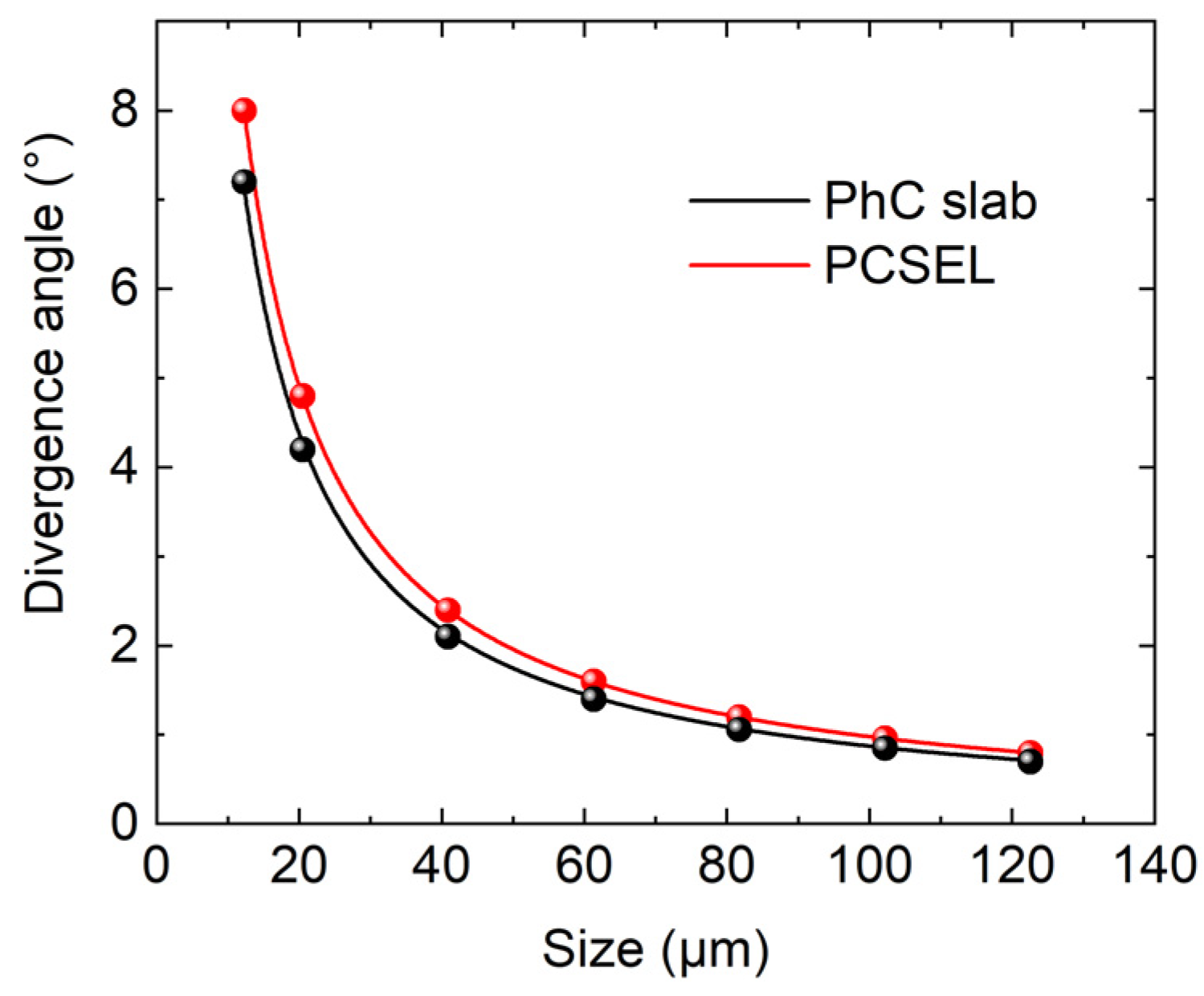Symmetry Criterion and Far-Field Control of Photonic-Crystal Surface-Emitting Lasers
Abstract
1. Introduction
2. Calculation Model and Method
3. Results and Discussion
3.1. The Impact of In-Plane PhC Structure
3.2. The Impact of Vertical Epi-Structure
3.3. The Impact of Period Number
4. Conclusions
Author Contributions
Funding
Institutional Review Board Statement
Informed Consent Statement
Data Availability Statement
Conflicts of Interest
References
- Yoshida, M.; De Zoysa, M.; Ishizaki, K.; Kunishi, W.; Inoue, T.; Izumi, K.; Hatsuda, R.; Noda, S. Photonic-crystal lasers with high-quality narrow-divergence symmetric beams and their application to LiDAR. J. Phys. Photonics 2021, 3, 022006. [Google Scholar] [CrossRef]
- Xu, J.; Cheng, Y.; Sugioka, K. Optics for beam shaping in laser processing. In Handbook of Laser Micro- and Nano-Engineering; Springer: Cham, Switzerland, 2021; pp. 527–543. [Google Scholar]
- Kaymak, Y.; Rojas-Cessa, R.; Feng, J.; Ansari, N.; Zhou, M. On divergence-angle efficiency of a laser beam in free-space optical communications for high-speed trains. IEEE Trans. Veh. Technol. 2017, 66, 7677. [Google Scholar] [CrossRef]
- Wang, Z.; Zhang, J.; Gao, H. Impacts of laser beam divergence on lidar multiple scattering polarization returns from water clouds. J. Quant. Spectrosc. Radiat. Transf. 2021, 268, 107618. [Google Scholar] [CrossRef]
- Winterfeldt, M.; Crump, P.; Knigge, S.; Maabdorf, A.; Zeimer, U.; Erbert, G. High beam quality in broad area lasers via suppression of lateral carrier accumulation. IEEE Photonics Technol. Lett. 2015, 27, 1809–1812. [Google Scholar] [CrossRef]
- Agrawal, G.P.; Dutta, N.K. Semiconductor Lasers; Kluwer Academic Publishers: Boston, MA, USA, 1993. [Google Scholar]
- Martinsson, H.; Vukusic, J.; Grabberr, M.; Michalzik, R.; Jager, R.; Ebeling, K.; Larsson, A. Transverse mode selection in large-area oxide-confined vertical-cavity surface-emitting lasers using a shallow surface relief. IEEE Photonics Technol. Lett. 1999, 11, 1536–1538. [Google Scholar] [CrossRef]
- Zhou, D.; Mawst, L.J. High-power single-mode antiresonant reflecting optical waveguide-type vertical-cavity surface-emitting lasers. IEEE J. Quantum Electron. 2002, 38, 1599–1606. [Google Scholar] [CrossRef]
- Bardinal, V.; Camps, T.; Reig, B.; Barat, D.; Daran, E.; Doucet, J.B. Collective micro-optics technologies for VCSEL photonic integration. Adv. Opt. Technol. 2013, 2011, 609643. [Google Scholar] [CrossRef]
- Chang, Y.-C.; Shin, M.C.; Phare, C.T.; Miller, S.A.; Shim, E.; Lipson, M. 2D beam steerer based on metalens on silicon photonics. Opt. Express 2021, 29, 854. [Google Scholar] [CrossRef]
- Engelberg, J.; Levy, U. The advantages of metalenses over diffractive lenses. Nat. Commun. 2020, 11, 1991. [Google Scholar] [CrossRef]
- Hirose, K.; Liang, Y.; Kurosaka, Y.; Watanabe, A.; Sugiyama, T.; Noda, S. Watt-class high-power, high-beam-quality photonic-crystal lasers. Nat. Photonics 2014, 8, 406–411. [Google Scholar] [CrossRef]
- Ishizaki, K.; De Zoysa, M.; Noda, S. Progress in photonic-crystal surface-emitting lasers. Photonics 2019, 6, 96. [Google Scholar] [CrossRef]
- Yoshida, M.; De Zoysa, M.; Ishizaki, K.; Tanaka, Y.; Kawasaki, M.; Hatsuda, R.; Song, B.; Gelleta, J.; Noda, S. Double-lattice photonic-crystal resonators enabling high-brightness semiconductor lasers with symmetric narrow-divergence beams. Nat. Mater. 2019, 18, 121–128. [Google Scholar] [CrossRef] [PubMed]
- Zhou, W.; Liu, S.-C.; Ge, X.; Zhao, D.; Yang, H.; Reuterskiold-Hedlund, C.; Hammar, M. On-chip photonic crystal surface-emitting membrane lasers. IEEE J. Sel. Top. Quantum Electron. 2019, 25, 4900211. [Google Scholar] [CrossRef]
- Lu, H.-Y.; Tian, S.-C.; Tong, C.-Z.; Wang, L.-J.; Rong, J.-M.; Liu, C.-Y.; Wang, H.; Shu, S.; Wang, L.-J. Extracting more light for vertical emission: High power continuous wave operation of 1.3-μm quantum-dot photonic-crystal surface-emitting laser based on a flat band. Light Sci. Appl. 2019, 8, 108. [Google Scholar] [CrossRef] [PubMed]
- Li, G.; Sarma, J.; Taylor, R.J.E.; Childs, D.T.D.; Hogg, R.A. Modeling and Device Simulation of Photonic Crystal Surface Emitting Lasers Based on Modal Index Analysis. IEEE J. Sel. Top. Quantum Electron. 2019, 25, 1–9. [Google Scholar] [CrossRef]
- Chen, L.-R.; Hong, K.-B.; Huang, K.-C.; Yen, H.-T.; Lu, T.-C. Improvement of output efficiency of p-face up photonic-crystal surface-emitting lasers. Opt. Express 2021, 29, 11293–11300. [Google Scholar] [CrossRef]
- Katsuno, S.; Yoshida, M.; Izumi, K.; Inoue, T.; Ishizaki, K.; De Zoysa, M.; Hatsuda, R.; Gelleta, J.; Enoki, K.; Noda, S. 29-W continuous-wave operation of photonic-crystal surface-emitting laser (PCSEL). In Proceedings of the 27th International Semiconductor Laser Conference (ISLC), Matsue, Japan, 16–19 October 2021. [Google Scholar]
- Morita, R.; Inoue, T.; De Zoysa, M.; Ishizaki, K.; Noda, S. Photonic-crystal lasers with two-dimensionally arranged gain and loss sections for high-peak-power short-pulse operation. Nat. Photonics 2021, 15, 311–318. [Google Scholar] [CrossRef]
- Inoue, T.; Yoshida, M.; Gelleta, J.; Izumi, K.; Yoshida, K.; Ishizaki, K.; De Zoysa, M.; Noda, S. General recipe to realize photonic-crystal surface-emitting lasers with 100-W-to-1-kW single-mode operation. Nat. Commun. 2022, 13, 3262. [Google Scholar] [CrossRef]
- Eiji, M.; Kyosuke, S.; Takayuki, O.; Wataru, K.; Dai, O.; Susumu, N. Lasers producing tailored beams. Nature 2006, 441, 946. [Google Scholar]
- Liang, Y.; Peng, C.; Sakai, K.; Iwahashi, S.; Noda, S. Three-dimensional coupled-wave analysis for square-lattice photonic crystal surface emitting lasers with transverse-electric polarization: Finite-size effects. Opt. Express 2012, 20, 15945–15961. [Google Scholar] [CrossRef]
- Yokoyama, M.; Noda, S. Finite-difference time-domain simulation of two dimensional photonic crystal surface-emitting laser. Opt. Express 2005, 13, 2869. [Google Scholar] [CrossRef] [PubMed]
- Wang, Z.; Liang, Y.; Beck, M.; Scalari, G.; Faist, J. Topological charge of finite-size photonic crystal modes. Phys. Rev. B 2020, 102, 045122. [Google Scholar] [CrossRef]
- Yokoyama, M.; Noda, S. Finite-difference time-domain simulation of two-dimensional photonic crystal surface-emitting laser having a square-lattice slab structure. IEICE Transanctions Electron. 2004, 87, 386–392. [Google Scholar]
- Bian, Z.; Rae, K.J.; McKenzie, A.F.; King, B.C.; Babazadeh, N.; Li, G.; Orchard, J.R.; Gerrard, N.D.; Thoms, S.; MacLaren, D.A.; et al. 1.5 μm epitaxially regrown photonic crystal surface emitting laser diode. IEEE Photonics Technol. Lett. 2020, 32, 1531–1534. [Google Scholar] [CrossRef]
- Itoh, Y.; Kono, N.; Fujiwara, N.; Yagi, H.; Katsuyama, T.; Kitamura, T.; Fujii, K.; Ekawa, M.; Shoji, H.; Inoue, T.; et al. Continous-wave lasing operation of 1.3-μm wavelength InP-based photonic crystal surface-emitting lasers using MOVPE regrowth. Opt. Express 2020, 28, 35483–35489. [Google Scholar] [CrossRef]
- Sakai, K.; Miyai, E.; Sakaguchi, T.; Ohnishi, D.; Okano, T.; Noda, S. Lasing band-edge identification for a surface-emitting photonic crystal laser. IEEE J. Sel. Areas Commun. 2005, 23, 1335–1340. [Google Scholar] [CrossRef]
- Sakoda, K. Optical Properties of Photonic Crystals; Springer: Berlin, Germany, 2004. [Google Scholar]





| PhC Structure | Symmetry of PhC | FFP | Symmetry of FFP | Divergence Angle (o) | |||||||||
|---|---|---|---|---|---|---|---|---|---|---|---|---|---|
| E | C4 | C42 | C4−1 | σx | σy | σd’ | σd’’ | x | y | ||||
| Single lattice | Circle | √ * | √ | √ | √ | √ | √ | √ | √ | Annular | C4v | 13.4 | 13.4 |
| Isosceles triangle | √ | √ | Elliptical single-lobed | E, σy | 11.0 | 12.1 | |||||||
| Isosceles right triangle | √ | √ | Circular single-lobed | E, σd’ | 11.0 | 11.0 | |||||||
| Multiple lattice | Double lattice 1 | √ | √ | √ | √ | Double-lobed | E, σd’ | 13.3 | 13.3 | ||||
| Double lattice 2 | √ | √ | √ | √ | Double-lobed | E, σy | 14.3 | 14.0 | |||||
| Double lattice 3 | √ | √ | Circular single-lobed | E, C42 | 10.3 | 10.3 | |||||||
| Undeformed triple lattice | √ | √ | √ | √ | √ | √ | √ | √ | Annular | C4v | 13.4 | 13.4 | |
| Deformed triple lattice | √ | Circular single-lobed | E | 10.8 | 10.6 | ||||||||
| Quadruple lattice | √ | √ | √ | √ | Circular single-lobed | E, C42 | 11.3 | 11.3 | |||||
Publisher’s Note: MDPI stays neutral with regard to jurisdictional claims in published maps and institutional affiliations. |
© 2022 by the authors. Licensee MDPI, Basel, Switzerland. This article is an open access article distributed under the terms and conditions of the Creative Commons Attribution (CC BY) license (https://creativecommons.org/licenses/by/4.0/).
Share and Cite
Wang, Z.; Wang, P.; Lu, H.; Meng, B.; Wang, Y.; Tong, C.; Wang, L. Symmetry Criterion and Far-Field Control of Photonic-Crystal Surface-Emitting Lasers. Appl. Sci. 2022, 12, 10581. https://doi.org/10.3390/app122010581
Wang Z, Wang P, Lu H, Meng B, Wang Y, Tong C, Wang L. Symmetry Criterion and Far-Field Control of Photonic-Crystal Surface-Emitting Lasers. Applied Sciences. 2022; 12(20):10581. https://doi.org/10.3390/app122010581
Chicago/Turabian StyleWang, Ziye, Pinyao Wang, Huanyu Lu, Bo Meng, Yanjing Wang, Cunzhu Tong, and Lijun Wang. 2022. "Symmetry Criterion and Far-Field Control of Photonic-Crystal Surface-Emitting Lasers" Applied Sciences 12, no. 20: 10581. https://doi.org/10.3390/app122010581
APA StyleWang, Z., Wang, P., Lu, H., Meng, B., Wang, Y., Tong, C., & Wang, L. (2022). Symmetry Criterion and Far-Field Control of Photonic-Crystal Surface-Emitting Lasers. Applied Sciences, 12(20), 10581. https://doi.org/10.3390/app122010581






